| THE ATMOSPHERE OF VENUS | |||
| For many years the thick atmosphere veiling the planet's surface allowed both scientists and fiction authors to suggest paradise-like environments, with abundant vegetation and aliens living a life of luxury. The truth revealed by spacecraft is that Venus is no paradise, and is nearer to traditional concepts of hell. Although Venus is close enough to Earth to allow observation of phases even with a small instrument like binoculars, the view is disappointing. There is very little atmospheric structure to be seen - no dramatic cloud belts and zones like Jupiter. Whereas the surface of Mars was studied for many years with Earth-based telescopes, the Venusian atmosphere prevents observation of the planet's surface. | |||
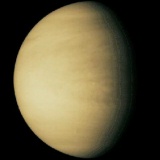 Only very subtle markings can be seen at optical wavelengths, as seen in this image captured by the Galileo spacecraft. Telescopically, Venus has little to offer. |
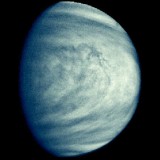 Atmospheric features become visible when the planet is observed in ultra-violet light, as shown in this view obtained by the Galileo spacecraft. Only the upper part of the atmosphere is revealed, with the patterns representing different chemical composition. |
||
| Super-rotation | |||
| These images, taken by the Pioneer Venus Orbiter spacecraft, demonstrate the existence of super-rotation in the upper atmosphere of Venus. | |||
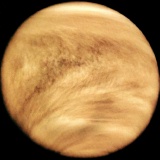 The left image shows the distinct shape of a letter "Y", on its side. This shape is a permanent feature. |
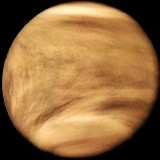 The right image shows the "Y" slowly disappearing from view. It takes 243 days for Venus to spin once on its axis, and yet the two images here were taken only 24 hours apart. It can be seen that the atmosphere of Venus is rotating far faster than the planet itself - in fact, sixty times faster. |
||
| Super-rotation can be found elsewhere in the Solar System - one example is the "prevailing westerlies" at Earth's mid-latitudes, but such super-rotation is usually a small addition to an already rapidly rotating planet. The Venusian super-rotation is a huge addition to a slowly rotating planet. | |||
| Changes in atmospheric features can be seen over a short period of time. | |||
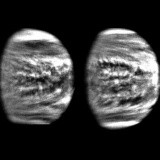 The image,obtained by Galileo, shows two views of Venus taken one day apart. Changes can be seen quite clearly. |
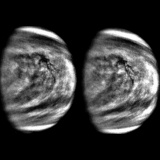 This image, showing views only a couple of hours apart, also has evidence of change, though as expected the differences are more subtle. |
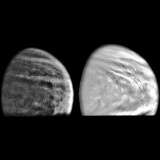 Different wavelengths can penetrate the atmosphere to different depths. The view on the right is in violet light, and shows the cloud deck at a height of 60 kilometres. When observed in near-infrared, at left, cloud structures 10 kilometres deeper can be seen. Studies of the clouds show that the higher clouds are moving westwards at 360 kilometres per hour, and the lower clouds at 240 kilometres per hour. |
|
| Atmospheric composition | |||
| The major constituent of the Venusian atmosphere is carbon dioxide, CO2 , making up 96.5% of the atmosphere. Nitrogen accounts for most of the remaining 3.5%. By contrast, the atmospheric abundance of carbon dioxide in Earth's atmosphere is a mere 0.035%. Venus has 260,000 times more carbon dioxide than Earth. There are also very small amounts of sulphur dioxide, water, argon, carbon monoxide, helium and neon. | |||
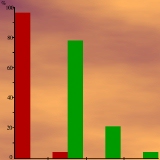 Atmospheric composition. |
|||
| Pressure | |||
| The Russian Venera spacecraft measured atmospheric pressure as they descended towards the surface of Venus. Venera 4 stopped transmitting when the measured pressure reached 20 bars, and this was at first thought to be the surface pressure value. In fact, the probes had been destroyed at high altitude by the severe pressure. A redesigned Venera 7 finally reached the surface and recorded a pressure of 92 bars. | |||
| The pressure on Earth's surface is 1.012 bars. In order to experience a 92 bar pressure you would have to dive to a depth of nearly a kilometre underwater. To stand on the surface of Venus you would have to be heavily armoured like a deep-sea diver. | |||
| Such a dense atmosphere has an effect on the Venusian landscape. It is difficult for Venusian volcanoes to put on explosive displays with such a crushing atmosphere above them. Explosions are suppressed, and lava tends to leak out from the volcanoes rather then be hurled into the air. | |||
| The thick atmosphere also causes smaller meteoroids to burn up rather than impact the surface. Consequently the Venusian surface lacks the usual range of small impact craters. | |||
| Temperature | |||
| As well as an impressive pressure of 92 bars, the Venera probes also recorded a surprising temperature of 740K (467oC). By comparison, the average temperature on Earth is 288K (15oC). The temperature at Venusian surface level is hot enough to melt lead. In fact, Venus is the hottest planet in the Solar System. Even Mercury, nearer to the Sun, is cooler. | |||
 Temperature profile. |
|||
| A temperature profile of the atmosphere, shown here, has been constructed from data returned by several missions to the planet. At high altitudes, Venus is colder than Earth. At low altitudes, Venus becomes far hotter than Earth. At an altitude of about 50 kilometres., The temperature is a comfortable 3oC and the pressure the same as that on Earth, possibly allowing an explorer to have a pleasant balloon flight. | |||
| What is the cause of the extreme temperature at low altitudes? The answer lies with the chemical composition of the atmosphere. Although the atmosphere is thick and cloudy, sufficient sunlight reaches the surface and warms the ground. Heat from the ground is then lost in the form of infrared radiation, but carbon dioxide is opaque to infrared. The heat is therefore trapped in the lower levels of the atmosphere. Furthermore, the great pressure of the atmosphere makes the carbon dioxide even more opaque. | |||
| This is known as the "greenhouse effect", named after the gardener's greenhouse. The glass allows sunlight to pass into the greenhouse, but being opaque to infrared radiation, it then traps the heat. | |||
| A similar greenhouse effect occurs on Earth, but as Earth's atmosphere only contains 0.035% carbon dioxide, temperatures are only raised by about 25o C. Nevertheless, without a greenhouse effect the average temperature on Earth would be below freezing. | |||
 Venus atmosphere. |
|||
| There is no diurnal temperature variation on the surface of Venus. That is, daytime and nighttime temperatures are the same. Nor is there a temperature variation between the equatorial and polar regions of the planet. The atmosphere acts as a massive thermal blanket maintaining constant temperatures across the planetary surface. | |||
| Winds and circulation | |||
| Like Mars and Earth, Venus too has Hadley cells. The atmosphere tends to rise from equatorial regions and flow towards the polar regions, where it cools, descends, and then flows back to the equator. Additional Hadley cells could transport heat away from the sub-solar point. | |||
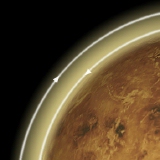 Hadley cells. |
|||
| The Hadley cell model works well for the lower atmosphere, but at higher altitudes, 50 kilometres and above, the planet's retrograde rotation has an influence. Here the atmosphere is much thinner, wind speeds are greater, and the atmosphere's super-rotation becomes dominant. | |||
| Cyclones and anti-cyclones, found on Earth and Mars, are not apparent on Venus. The slow rotation of Venus reduces the Coriolis force, responsible for deflecting north-south winds towards the east or west. Like Mars and Earth, Venus has thermal tides. At high altitudes, winds flow from the warmer day side of the planet to the cooler night side. Surface wind speeds can reach 3 kilometres per hour, sufficient to cause erosion of the landscape, as seen in this Magellan radar image of Adivar Crater. | |||
 Magellan image of Venus' Adivar Crater showing evidence of wind erosion. |
|||
| Clouds | |||
| Measurements made by the Pioneer Venus spacecraft have determined that the clouds of Venus exist in three layers. There is also a thin haze that extends below the lower layer down to an altitude of about 30 kilometres. | |||
| The upper layer appears to consist of particles with a diameter of around 1 micrometer, making the upper layer more of a haze than a cloud deck. The middle layer particles reach 2 micrometres in size, whilst the lower layer contains particles up to 6 micrometres across. | |||
| Although the chemical composition of the clouds is not directly proven, the particles do have the optical characteristics of sulphuric acid, H2SO4 The acid particles slowly descend to lower altitudes, but lower altitudes mean higher temperatures, and the acid evaporates. Should the acid reach even lower levels it will be decomposed into water, sulphur dioxide, and oxygen. Atmospheric currents then carry the constituents back up into the clouds. The acid clouds absorb the water, and the Sun's ultraviolet light converts the sulphur dioxide back into sulphuric acid. | |||
| Many years of observations have confirmed variations in the amount of sulphur dioxide in the atmosphere, and the consequential amount of sulphuric acid. A possible cause is volcanic activity - sulphur dioxide is a product of volcanic eruptions. | |||
| Although there is an altitude at which the temperature and pressure are comfortable for humans, it lies at the same height as clouds of sulphuric acid, so the explorer's balloon flight is out of the question. | |||
|
|
|||
| Seasons | |||
| Venus has a nearly circular orbit, with perihelion and aphelion having no major difference in solar irradiation. The axial tilt too is insignificant, and therefore the primary causes of seasonal temperature changes are missing. Add to this the very long day (243 days), and the thermal topet effect of the atmosphere, and the result is that there is no Venusian summer or winter. However, when surface temperatures can melt lead, tin and zinc, seasonal variation is a bit academic. | |||
|
|
|||
